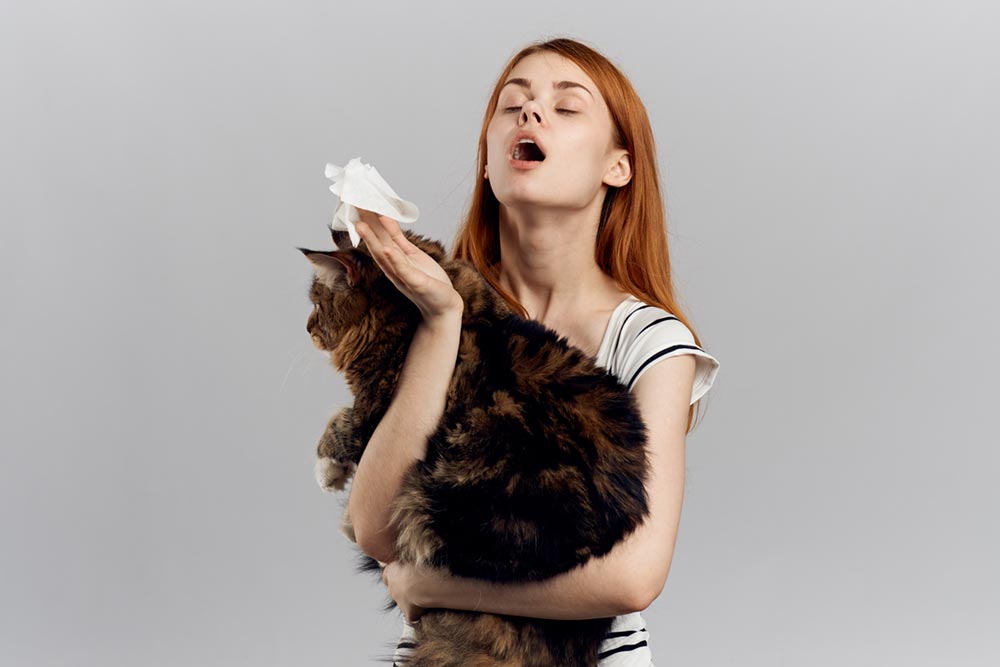Maine Coon cats are one of the largest breeds, with the capability to weigh up to eighteen pounds. They are known for their good-natured, kind personalities. Sounds perfect, right? Unfortunately, a large population for whom Maine Coons won’t work: people with cat allergies.
Maine Coon cats are NOT hypoallergenic. Hypoallergenic means it’s less likely to cause an allergic reaction. However, due to their size & long-hair coats, Main Coon cats are not necessarily a good match for people with cat allergies. Grooming your Main Coon cat regularly will help reduce hair shedding, but it may not be enough if you have allergies. Let’s look at the details.
What is a Maine Coon cat?
The Maine Coon is a domesticated breed of cats. Descending from Norwegian Forest cats, they boast long fur and diverse coloring. The Maine Coon is the third most popular pedigreed cat breed. As the name hints, this breed hails from New England, where they were used on ships to kill mice. Which might have helped develop the breed’s affinity for water!

Maine Coons cats are not heavy shedders but have long-hair coats
Surprisingly, Maine Coons shed the same as their short-haired counterparts. However, their long-hair coats can still be a problem for people with cat allergies.
How do cat allergies work?

Approximately ten percent of the United States population suffers from pet allergies. To double down, cat allergies are twice as common as dog allergies. Surprisingly, the hair isn’t the problem; it’s their saliva and castoffs.
Allergies are due to overactive immune systems. When our immune systems encounter something unfamiliar, they create antibodies to fight them. Usually, this occurs with an illness. In people with allergies, the immune system freaks out over pet dander, saliva, and more. The immune system creates antibodies, attacking.
While Maine Coons don’t produce an unusual amount of Fel d1, the problem can be their long coats: long-hair cats require more grooming and maintenance than a short-haired cat. Cats spend between thirty to fifty percent of their time grooming, which is a lot of protein.
Signs of cat allergies
The most common symptoms of cat allergies include:
- Coughing or wheezing
- Hives or rash
- Itchy eyes
- Sneezing
- Runny or stuffy nose
- Congestion

You may notice these have a lot in common with the symptoms you get when you’re sick. The immune system in those allergic to cats reacts the same way, producing the same symptoms. These are your body’s response to foreign invaders.
Additionally, allergy symptoms don’t always happen right away. The reaction can take time depending on the person. Some react within minutes, while others reap the consequences hours later.
If you’re concerned regarding a possible reaction, you can have your doctor conduct a blood or skin test.
Mixed-breed Maine Coon and allergies
The look of the Maine Coon is pretty distinctive. There is usually no doubt between the oversized paws, large ears, and body size. Additionally, purebred Maine Coon owners tend to get their babies from breeders, which guarantees their ancestry.

But as all cats do, they interbred. This creates mixed Maine Coons, which can have varying levels of distinct traits. This can make it hard to tell if you have a mixed breed.
- Size: Mixed Maine Coons are not as large as the purebred cousins. Mixed bred usually grow for two to three years compared to purebreds, who grow up to five years.
- Ruff: Mixed can have the distinct ruff around the neck like a lion mane. Additionally, their undercoats are thick. It can range from medium to long-haired.
- Ears: If the ears are on the sides of the head or are very pointy, the cat could be mixed.
It’s hard to determine whether a mixed Maine Coon will be more hypoallergenic than their purebred friends. With hybrid breeding, genetics can be wonky, producing unlikely combinations. If you are concerned or severely allergic, it may be better to avoid these friendly creatures.
How can I reduce my allergic reactions to a Main Coon cat?
If you’re reacting to your Maine Coon, you’ll probably wonder if there’s anything you can do. Luckily, a few tricks up our sleeve may reduce your reaction or allergy. And honestly, they’re not too hard. Please don’t try these if you are severely allergic to cats. Consult with a doctor.
HypoCat
The newest treatment for helping those who suffer from cat allergies is a vaccine called HypoCat. This is intended for cats to reduce antibody production, which would produce fewer allergens. There are ten allergens produced by cats, but eighty to ninety percent of allergy sufferers are allergic to Fel d1.
Diet
Purina and other pet companies have been trying to develop a diet to reduce the number of allergens produced by cats. Purina tested a food product that lowered Fel d1 levels by approximately thirty percent for most cats in the study.
Break
While most animal lovers prefer to sleep with us, a safe space away from allergens can be an excellent compromise. If you keep one room allergen-free, it would be a haven.
Air Filter
These can be expensive, but an air filter can be helpful to reduce the hair and dander in your home’s air. Just make sure you take the plastic off the filter first.
Low Dust Litter
It’s always better to avoid contact with litter if allergic, but sometimes we don’t have a choice. Low dust litter is best for those with cat allergies to reduce the number of allergens in the air.
Spay or Neuter
Surprisingly, spaying or neutering your cat will lower the number of allergens they produce.
Bath
Maine Coons love water, but most cats don’t enjoy baths. There’s something about it being their choice. However, baths and special shampoo can reduce the number of allergens.
No Carpets
Cats track allergens wherever you go. Carpets contain up to thirteen times more allergens than smooth floors. If you have the opportunity, it would be wise to replace the carpet with smooth flooring. Additionally, allergic people could wear a mask while vacuuming to avoid inhaling airborne allergies.
Laundry
Just like carpet, allergens stick to bedding. It would be best to wash your bedding twice monthly in hot water to eliminate dust mites and cat allergens.
Trial
You never will know your reactions to a cat unless you experience it. If a friend owns a Maine Coon or a shelter near you, you could have a trial period to see whether there is a reaction.
Exposure
This should not be relied upon. Some people, with enough exposure, develop an immunity to their own. Their body becomes used to that specific protein, lessening reactions. However, allergies are just as likely to worsen with more exposure. You should contact your doctor before attempting exposure therapy. They may have advice to offer.
Can grooming my Maine Coon reduce allergic reactions?
One of the most prominent features of Maine Coons is their long-haired fur. Sadly, dead hair falls off all-around your house. Maine Coons require more attention to their mane than short-haired compatriots. However, grooming may reduce allergic reactions.

- Start Young: If you have a Maine Coon, it’s best to start grooming them when they are a kitten. This gets them used to the sensation.
- Time: Don’t rush the process. Initially, it’s best to take it slow and follow your cat’s preferences. Grooming is often a communal process for cats.
- Regular: It’s best to establish a routine for Maine Coons. It’s best to brush them two to three times a week to remove hair and dander. Additionally, it prevents tangles and mats.
- Trimming: While not necessary, some owners find it helps to keep the Maine Coon’s fur trimmed. It can be hot, especially in the summer. Regular grooming trips can help prevent a lot of dander.
What cats cause the most allergies?
For most people, cat allergies are caused by the Fel d1 protein scattered by their dander, saliva, and other body excretions.
Some cat breeds are more prone to causing allergic reactions:
- Maine Coons: This breed descended from Norwegian Forest cats has dense fur, and will shed quite a bit – but not necessarily more than other cat breeds.
- Persians: As kittens, they resemble cotton balls. But adults still maintain a fluffy coat, which sheds heavily compared to other breeds.
- Ragdolls: These are moderate shedders that require regular grooming. If you’re sensitive, these are not hypoallergenic.
- British Longhairs: These kittens have high-maintenance coats which shed frequently. They require regular grooming, putting owners in constant contact with the protein.
- Norwegian Forest: This breed is closer to one or two people but has a shaggy furry coat. It tends to be dense and thick to protect from harsh temperature extremes.
- Cymric: This breed has a heavy undercoat. It requires moderate grooming.
- Himalayan: These have a double coat, and both are fluffy. This requires quite a lot of grooming but still sheds.
- Toyger: Created from breeding Bengal, their fur is soft but thick. They shed moderately.
- Birman: The thick, long fur is trouble as these cats love to cuddle. Their shed moderately but love physical contact.
- Scottish Fold: These cats are distinguished by their droopy ears and large eyes. They tend to be sweet and get along well with anyone. However, they have thick and dense fur, which sheds moderately.
Best hypoallergenic cat breeds
Looks can be deceiving. You would think those with long hair equals allergies and those with short hair don’t. While that may be true for most breeds, some break the mold.
The best hypoallergenic cat breeds include:
- Balinese: They have a long coat and are known as low shedders. They may have lower levels of the Fel d1 protein.
- Javanese: This is a mix between Siamese and shorthair. However, these cats don’t have an undercoat, lessening exposure to allergens.
- Devon Rex: The wavy coat here doesn’t shed much, which minimizes the exposure to the allergens.
- Cornish Rex: The wavy hair is deceiving. Rexes have a fine undercoat and no topcoat.
- Sphynx: Some people are creeped out by the “hairless” nature. However, their body is covered in fine fuzz. These cats need to be bathed frequently to remove excess oil, which corresponds with removing dander.
- Siberian: These long-haired beauties produce low levels of the Fel d1 protein, which helps out allergy sufferers.
- Siamese: Like their Javanese cousins, Siamese has a low-maintenance coat that doesn’t shed much. However, they tend to have a favorite human, which may trigger allergies.
- Russian Blue: The beautiful gray coat is low-shedding, requiring only weekly brushing. It’s good because these cats love to sit on their humans.

